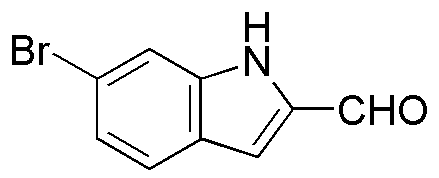6-Bromo-1H-indole-2-carbaldehyde is widely utilized in research focused on:
- Synthesis of Pharmaceuticals: This compound serves as a key intermediate in the synthesis of various pharmaceutical agents, particularly in the development of drugs targeting neurological disorders.
- Fluorescent Probes: It is employed in the creation of fluorescent probes for biological imaging, enhancing the visualization of cellular processes in research settings.
- Organic Electronics: The compound is used in the fabrication of organic electronic materials, contributing to the development of efficient organic light-emitting diodes (OLEDs) and solar cells.
- Biochemical Research: Researchers utilize it to study enzyme interactions and metabolic pathways, aiding in the understanding of various biological mechanisms.
- Material Science: It plays a role in the development of novel materials with unique properties, such as conducting polymers, which have applications in sensors and energy storage.
General Information
Properties
Safety and Regulations
Applications
6-Bromo-1H-indole-2-carbaldehyde is widely utilized in research focused on:
- Synthesis of Pharmaceuticals: This compound serves as a key intermediate in the synthesis of various pharmaceutical agents, particularly in the development of drugs targeting neurological disorders.
- Fluorescent Probes: It is employed in the creation of fluorescent probes for biological imaging, enhancing the visualization of cellular processes in research settings.
- Organic Electronics: The compound is used in the fabrication of organic electronic materials, contributing to the development of efficient organic light-emitting diodes (OLEDs) and solar cells.
- Biochemical Research: Researchers utilize it to study enzyme interactions and metabolic pathways, aiding in the understanding of various biological mechanisms.
- Material Science: It plays a role in the development of novel materials with unique properties, such as conducting polymers, which have applications in sensors and energy storage.
Documents
Safety Data Sheets (SDS)
The SDS provides comprehensive safety information on handling, storage, and disposal of the product.
Product Specification (PS)
The PS provides a comprehensive breakdown of the product’s properties, including chemical composition, physical state, purity, and storage requirements. It also details acceptable quality ranges and the product's intended applications.
Certificates of Analysis (COA)
Search for Certificates of Analysis (COA) by entering the products Lot Number. Lot and Batch Numbers can be found on a product’s label following the words ‘Lot’ or ‘Batch’.
*Catalog Number
*Lot Number
Certificates Of Origin (COO)
This COO confirms the country where the product was manufactured, and also details the materials and components used in it and whether it is derived from natural, synthetic, or other specific sources. This certificate may be required for customs, trade, and regulatory compliance.
*Catalog Number
*Lot Number
Safety Data Sheets (SDS)
The SDS provides comprehensive safety information on handling, storage, and disposal of the product.
DownloadProduct Specification (PS)
The PS provides a comprehensive breakdown of the product’s properties, including chemical composition, physical state, purity, and storage requirements. It also details acceptable quality ranges and the product's intended applications.
DownloadCertificates of Analysis (COA)
Search for Certificates of Analysis (COA) by entering the products Lot Number. Lot and Batch Numbers can be found on a product’s label following the words ‘Lot’ or ‘Batch’.
*Catalog Number
*Lot Number
Certificates Of Origin (COO)
This COO confirms the country where the product was manufactured, and also details the materials and components used in it and whether it is derived from natural, synthetic, or other specific sources. This certificate may be required for customs, trade, and regulatory compliance.

